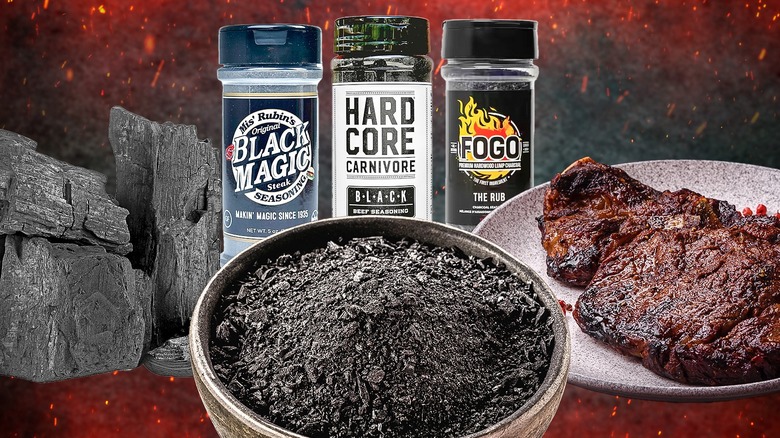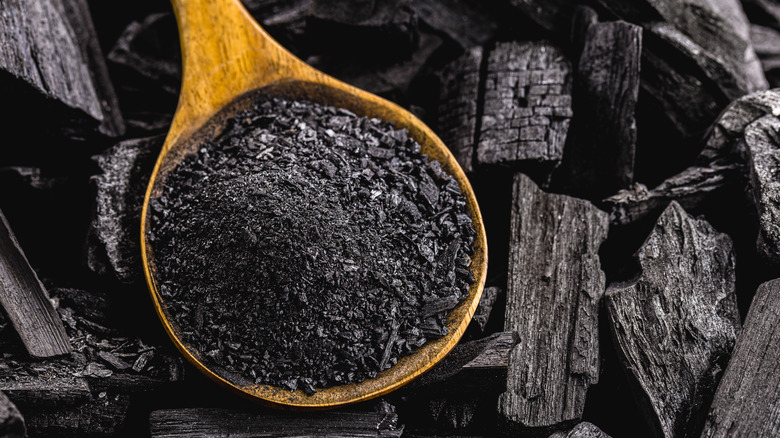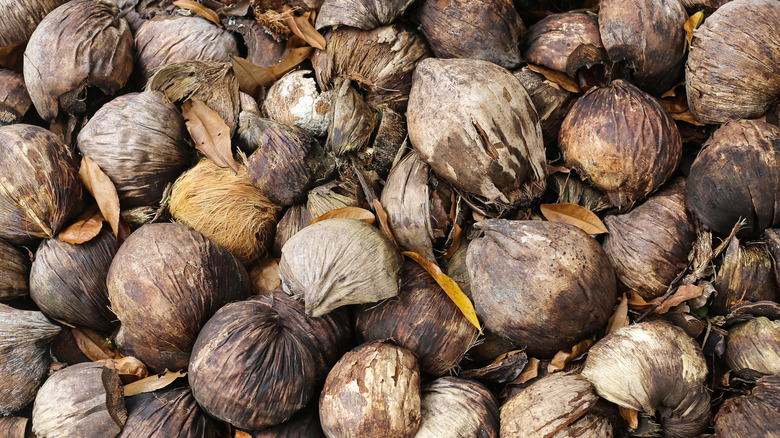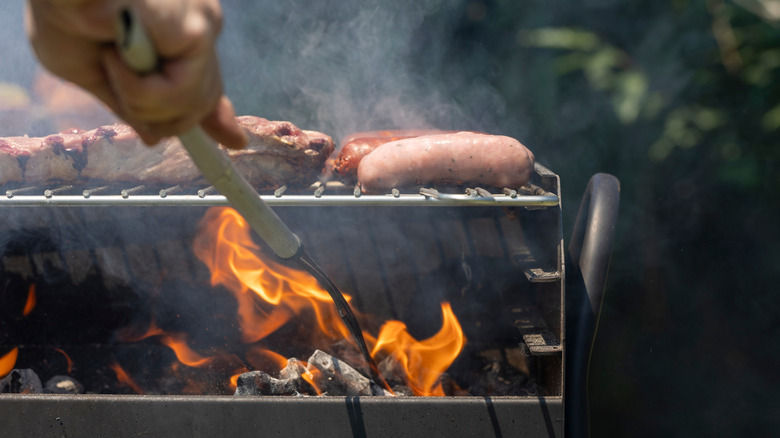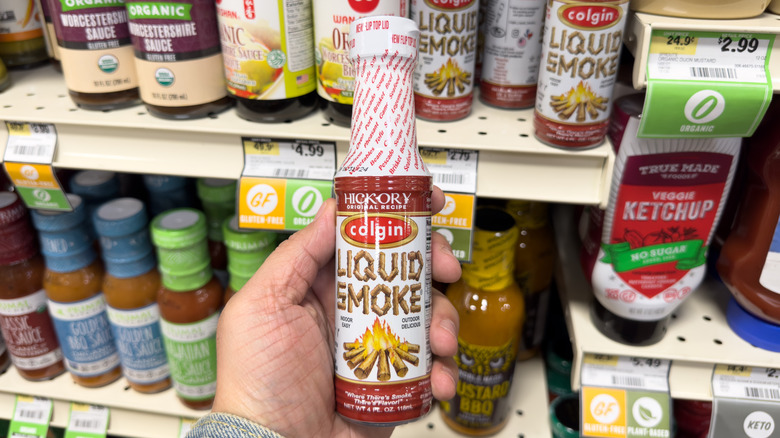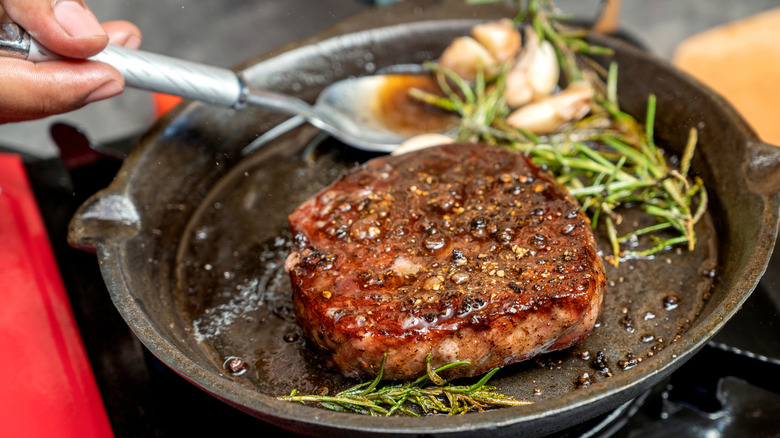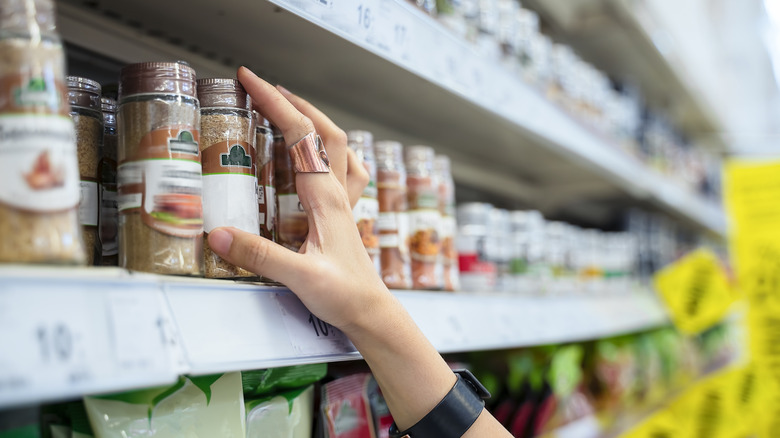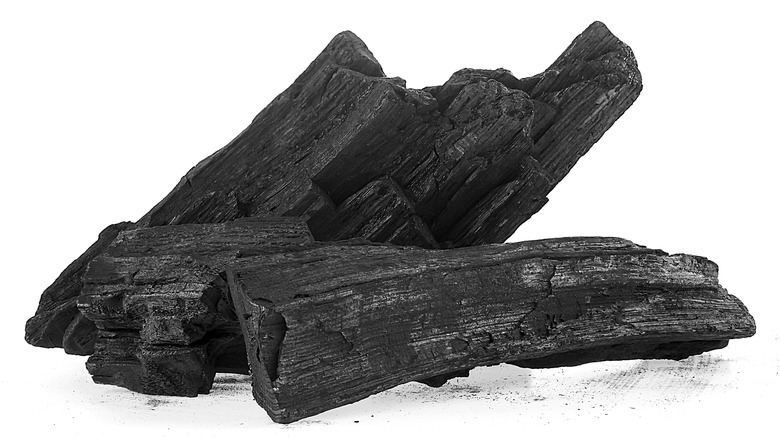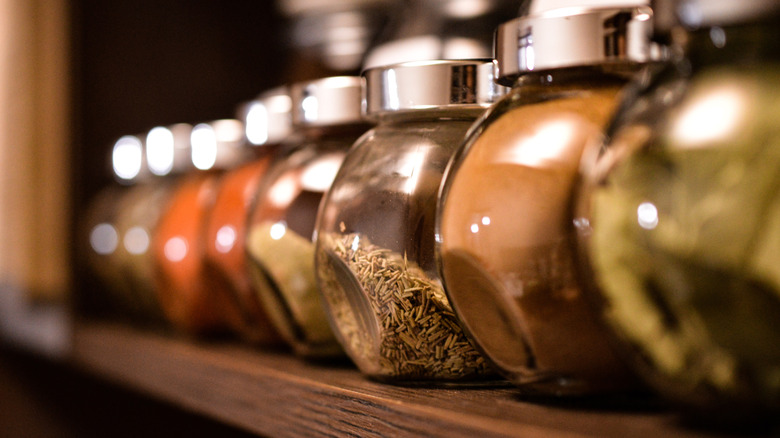What Is Charcoal Seasoning And How Do You Use It?
We may receive a commission on purchases made from links.
Remember when charcoal became one of the biggest food trends nearly 10 years ago? It was hard to go anywhere without seeing pitch black ice cream cones, lattes, burger buns, and bagels advertised on every corner. These foods tasted pretty similar to their normal-colored counterparts, but the addition of activated charcoal gave them a dark hue. It was also often touted for its claimed health benefits, and at the very least, it made for a unique visual experience.
The charcoal fad may have come and gone, but charcoal seasoning didn't quite get its due as an uncommon addition to the spice cabinet that can shake up your cooking routine. Charcoal seasoning, unlike plain activated charcoal, is all about intense flavor. More specifically, it captures the smoky magic of a charcoal grill in a bottle, an easy way to give your food that taste without having to fire up the grill. Once you know how to use it, charcoal seasoning can help anyone become a veritable pitmaster in the comfort of their own kitchen. We've got everything you need to know about this unique ingredient.
What is charcoal seasoning?
Charcoal seasoning looks like a lot of other spice blends you might already have in stock, except the powdery mixture is all (or mostly) black in color. Its primary ingredient is food grade activated charcoal, a black powder made from carbon-rich material that is safe to ingest. But activated charcoal can be found in many products beyond food, like toothpaste, skincare, odor absorbers, and water filters. It's even used in hospitals as a medication to treat certain kinds of oral poisonings and overdoses. That's because activated charcoal is highly porous, so it can easily bind to some chemicals like the toxins in poison, preventing them from being absorbed through the stomach.
The rest of the charcoal seasoning blend can be a variety of spices you'd typically want to rub onto a hearty steak or veggies before they hit the grill, like black pepper, garlic powder, paprika, and dried herbs. Some might include brown sugar for a touch of sweetness, or chili powder for those who like it spicy.
How is charcoal seasoning made?
To make charcoal seasoning, the first thing you need is charcoal. Food grade activated charcoal can be made from plant-based materials like bamboo or hardwood, but most often you'll see coconut shells on the nutrition label; they produce high quality charcoal thanks to their tough structure and density.
Whichever shell or wood you start with, it's then burned at a very high temperature in a low oxygen environment, leaving behind mostly carbon residue, aka charcoal. But what makes it "activated"? The charcoal is exposed to a gas or chemical like steam, oxygen, or phosphoric acid, which creates all those tiny pores that dramatically increase the charcoal's surface area and helps it absorb other chemicals. Food grade activated charcoal is thoroughly washed to remove any residue and impurities, then dried and finely ground into a black powder. It's finally ready to get packed into the spice jar with the rest of the charcoal seasoning blend.
What does charcoal seasoning taste like?
The point of using charcoal seasoning is to mimic the taste of food that hit the grill, which can feel like a lot of work if you're still a beginner grill master. The activated charcoal lends the smoky, earthy flavor you get from the grill, but you won't get any hints of salt, spice, or herbs on its own. The charcoal taste is subtle and mild; it's not going to overpower your dish and make it taste like a campfire. Instead, it adds a roasted depth that gives your food that just-off-the-grill impression, even if it never touched a flame.
To get the big, bold flavors we know and love at the backyard cookout, the rest of the spice blend works to amplify the taste of the charcoal. It might include other smoky flavors like smoked paprika, but the exact taste will depend on the blend of your choice, whether you're looking for a classic barbecue flavor, something sweet and savory, or a pure umami bomb.
Charcoal seasoning versus liquid smoke
There's more than one way to hack the smoky flavor of the grill, and liquid smoke is another common option. It's made by capturing the smoke from burning wood chips and letting it cool, which causes the smoke to condense into liquid form. Liquid smoke is already added to plenty of items at the grocery store like sauces, prepared meat, nuts, and cheese, but you can buy a bottle of it for anything you're cooking that needs a dose of that smoldering flavor.
The taste of liquid smoke is much more concentrated than the activated charcoal in charcoal seasoning, so just a few drops will go a long way. But you'll have to add your own spices to give your food more tasty dimension, which charcoal seasoning already provides in one step. Charcoal seasoning can also help give any meat you're roasting a crust for that desired crispy texture — it has the side effect of turning your food black, but if you're into it, an all-black steak makes an impressive sight on the dinner table.
How to cook with charcoal seasoning
You can treat charcoal seasoning like any other spice blend or dry rub you have in the pantry to coat meat and vegetables. Start with common ingredients that are well-suited for actual grilling, like steak, pork chops, chicken, burgers, ribs, corn on the cob, bell peppers, and squash. But instead of firing up the grill, simply pan roast the meat on the stove or broil the veggies in the oven to bring out the smoky, charred flavor with a lot less work. If you've coated a lot of charcoal seasoning on a piece of meat to create a crust, be careful to not cook at too high a temperature to prevent the seasoning from burning before the meat is cooked through.
There are plenty of other ways to get creative with charcoal seasoning, like shaking it over some oven-baked fries or a bowl of popcorn. Consider adding it to marinades, sauces and dips that could use a smoky twist, or even a hearty bowl of soup or stew to create more depth of flavor. And if you're already a real-life grillmaster, use it on the grill to double up the smoky intensity!
Where to buy charcoal seasoning
Head to the spice aisle at your grocery store and you might find charcoal seasoning next to the steak spices and rubs; you can even find it in stores like Home Depot and Bass Pro Shops near the grilling supplies. But charcoal seasoning isn't flying off the shelves since it's not a particularly well known spice blend, so you may have to seek it out from online stores and the manufacturers themselves if you can't find it in person. Mis' Rubin's Black Magic Seasoning could only be bought from the Alabama butcher shop where it was created for many years, but now you can order it Amazon. Hardcore Carnivore's Black Beef Seasoning is another popular option among meat lovers that's easy to find online. Wherever you get it from, just make sure activated charcoal is on the label. For jars with the most intense smoky flavor, also look for smoked salts, chilis or paprika in the ingredient list.
If you even want to make it yourself at home, just buy food grade activated charcoal and mix it up with salt and spices. Don't know where to start? Try common steak spices like black pepper, garlic powder, onion powder, parsley, oregano, thyme, and rosemary.
Nutritional information about charcoal seasoning
Most charcoal seasoning blends on the market contain salt, a natural flavor enhancer that makes the entire blend more tasty. Keep that in mind while preparing the ingredients you'll use the seasoning on — they might need less salt on its own.
Activated charcoal can be found in many products outside of the grocery aisles because it's often cited as a detox product. If doctors can use it to remove certain toxins from patients who've been poisoned, then it makes sense it could remove impurities from your skin, teeth, or within the body if ingested, right? But the science behind these claimed health benefits is limited. Like many other products that claim to have detoxifying properties, there's little scientific evidence that it can generally cleanse the body of unwanted substances, which your body is already good at doing thanks to the kidneys, liver and digestive system.
When it comes to charcoal seasoning, activated charcoal is all about flavor and color, but it's no health supplement. There is evidence that consuming activated charcoal can make some medications less effective by absorbing the drug, but the risk is small if used sparingly, and a sprinkle of charcoal seasoning contains little activated charcoal overall. To be really safe, wait a couple hours after taking medication before you dig into a charcoal-seasoned meal.
How to store charcoal seasoning
If you don't want its smoky flavor to dissipate like actual smoke, knowing how to store charcoal seasoning will make it last for awhile. That said, you might want to treat charcoal seasoning a little more carefully than your other spice jars — it may be more susceptible to degrading if the activated charcoal happens to absorb any moisture or odors it comes in contact with. To prevent this, keep it in an airtight container with a tight lid in a cool, dry place away from sunlight, like a cabinet drawer or the pantry.
Like other spices, try to avoid shaking the seasoning directly over a hot pan of food on the stove, because the heat and moisture will degrade its freshness and flavor and can create clumping. It's also a good idea to label the jar with the date of purchase so you'll know when a year has passed, which is when most spices have gone stale and need to be replaced. If you see clumping, if the smell is off, or the smoky flavor just isn't as strong as you remember, it's time to move on to a fresh jar.
